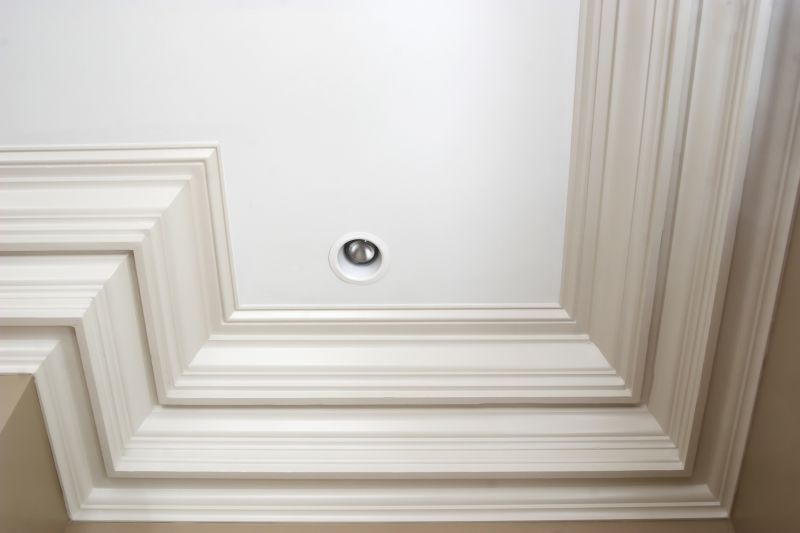Expert Picks For Crown Molding Installation Supplies To Enhance Your Workspace
Find out which products professionals trust for smooth, accurate crown molding installations and long-lasting results.
 Crown molding installation is a popular method to add architectural interest and elegance to interior spaces. To achieve a professional-looking finish, a variety of specialized products are available to assist with measuring, cutting, and securing crown moldings. These products range from simple hand tools to advanced mounting systems, each designed to streamline the installation process and ensure precise results. Selecting the right products depends on the scope of the project, the type of crown molding being used, and personal skill level.
Crown molding installation is a popular method to add architectural interest and elegance to interior spaces. To achieve a professional-looking finish, a variety of specialized products are available to assist with measuring, cutting, and securing crown moldings. These products range from simple hand tools to advanced mounting systems, each designed to streamline the installation process and ensure precise results. Selecting the right products depends on the scope of the project, the type of crown molding being used, and personal skill level.
Types of Products For Crown Molding Installations
Miter Saws
Power tools used to make precise angled cuts essential for fitting crown molding corners.
Measuring Tapes and Levels
Tools for accurate measurement and ensuring level and plumb installation of moldings.
Cutting Guides and Jigs
Accessories that assist in making consistent, accurate cuts for crown molding pieces.
Adhesives and Caulks
Products used to bond crown molding to walls and conceal joints for a seamless look.
Nail Guns and Fasteners
Power tools and fasteners designed for quick and secure attachment of molding.
Corner Blocks and Connectors
Pre-made or adjustable pieces that help create clean corners and transitions.
Sanders and Finishing Tools
Tools for smoothing surfaces and preparing moldings for painting or staining.
Ladders and Scaffolding
Support equipment for reaching high areas safely during installation.
Leveling and Alignment Tools
Devices that help ensure crown molding is installed straight and true.
Filler and Putty
Materials used to fill nail holes and seams for a flawless finish.
Popular Choices
Widely used for creating neat corners, these blocks are adjustable to fit various angles and moldings.
Favored for their portability and ease of use, these nailers facilitate quick attachment of crown moldings.
Popular for ensuring precise alignment and straight installation across large wall spans.
Preferred for their ability to make accurate angled cuts, essential for corner joints.
Essential for accurate measurement, these tools are frequently used in crown molding projects.
Trending for their ease of installation and ability to adapt to various corner angles.
Popular for finishing seams and nail holes, providing a smooth, paintable surface.
Commonly used for reaching high ceilings safely during installation.
Often chosen for finishing work to achieve smooth surfaces before painting.
Helpful for securing pieces during gluing or drying phases.
Successful crown molding installation often requires accurate measurements and clean cuts, which can be facilitated by specialized tools such as miter saws, cutting guides, and measuring tapes. Once the molding is cut to size, securing it firmly to the wall and ceiling is crucial for a seamless appearance. Adhesives, nails, and mounting brackets are common options, with some products offering combination solutions for added stability. Additionally, finishing products like caulk and filler help conceal seams and nail holes, creating a polished look.
For those undertaking larger projects or seeking professional results, investing in quality products can make a significant difference. From adjustable angle finders to specialized lubricants, the right tools help reduce installation time and improve accuracy. Whether you're a DIY enthusiast or a seasoned contractor, understanding the available product options can help you select the most suitable tools and accessories for your crown molding installation endeavors.
Key Buying Considerations
- Determine the type of crown molding profile to match your decor style.
- Assess the complexity of your project to choose appropriate tools and accessories.
- Consider the angles involved in corners to select compatible corner connectors or blocks.
- Evaluate the power source options for tools like nailers and saws—corded or cordless.
- Check the compatibility of cutting tools with the size and shape of your molding material.
- Prioritize safety features such as blade guards and ergonomic designs in power tools.
- Review the weight and portability of ladders and scaffolding for ease of use.
- Ensure measuring and leveling tools are accurate and easy to read.
- Select adhesives and fillers that are suitable for your molding material and finishing needs.
- Think about storage and organization options for tools and accessories after project completion.
- Consider the overall project scope to determine if professional-grade tools are necessary.
- Look for products with positive user reviews regarding ease of use and durability.
- Budget accordingly, balancing quality and cost for long-term value.
- Check for compatibility with existing tools or materials you already own.
- Review warranty and customer support options for higher-end tools and systems.
